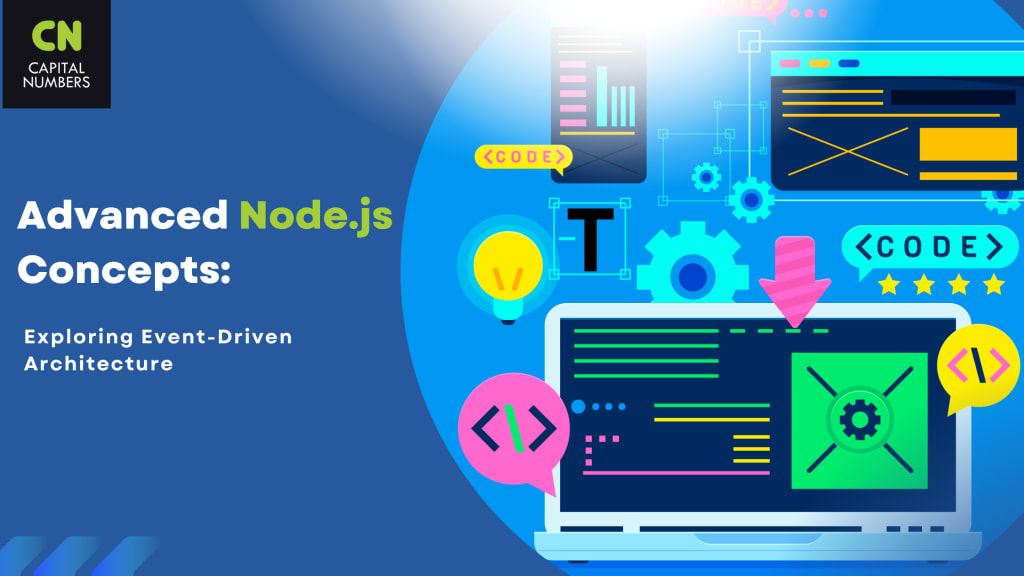Advanced Node.js Concepts: Exploring Event-Driven Architecture
Unleashing the Power of Event-Driven Architecture in Node.js Development

In recent years, Node.js has gained significant popularity among developers due to its efficient and scalable nature. It allows developers to build high-performance applications by leveraging its event-driven architecture. In this article, we will delve into advanced Node.js concepts and explore the fascinating world of event-driven architecture.
We will cover the basics of event-driven programming, understand the event loop, and discuss how to effectively utilize event-driven architecture in Node.js applications.
What is Event-Driven Architecture?
Event-driven architecture is a design pattern where the flow of an application is determined by events. In this paradigm, components of an application communicate with each other by emitting and handling events. The event-driven approach allows for loose coupling between components, making the application more modular and scalable.
Understanding Events and Event Emitters
Events are occurrences or changes in a system that is worth noting and responding to. In Node.js, the core module ‘events’ provides the ‘EventEmitter’ class, which allows you to create, emit, and handle events. Understanding event emitters are crucial for effectively utilizing the event-driven architecture in Node.js.
The Event Loop: Backbone of Node.js
The event loop is a fundamental concept in Node.js that enables non-blocking, asynchronous behavior. It ensures that the application remains responsive by efficiently managing I/O operations and callbacks. We will explore how the event loop works and its significance in the Node.js runtime.
Building Asynchronous Applications with Callbacks
Callbacks are a traditional way of handling asynchronous operations in Node.js. We will discuss how to work with callbacks effectively, manage callback hell, and write clean and maintainable asynchronous code.
Leveraging Promises and Async/Await
Promises and async/await are modern approaches to handle asynchronous operations in Node.js. We will explore the benefits of using promises and how async/await simplifies asynchronous code, making it more readable and maintainable.
Implementing Event-Driven Patterns
The Event-driven architecture enables the implementation of various design patterns. We will dive into some popular patterns, such as the pub-sub pattern, observer pattern, and stream pattern, and understand their use cases in Node.js applications.
- Pub-Sub Pattern: The pub-sub (publish-subscribe) pattern is a messaging pattern where senders of messages, called publishers, do not directly communicate with specific receivers, called subscribers. Instead, publishers publish messages to specific channels or topics, and subscribers who are interested in those topics receive the messages. This pattern enables loose coupling between publishers and subscribers, allowing for scalability and flexibility in the system architecture. We will discuss how to implement the pub-sub pattern in Node.js and explore its use cases.
- Observer Pattern: The observer pattern is a design pattern where an object, called the subject, maintains a list of its dependents, called observers. When the subject undergoes a state change, it notifies all its observers, and they update themselves accordingly. In the context of event-driven architecture, the observer pattern is commonly used to handle event notifications and reactions. We will explore how to implement the observer pattern in Node.js and discuss scenarios where it can be applied effectively.
- Stream Pattern: The stream pattern involves the continuous flow of data from a source to a destination. In Node.js, streams are used to process large amounts of data in a memory-efficient and non-blocking manner. Streams allow you to read or write data in chunks, making them ideal for handling data that doesn't fit entirely in memory. We will delve into the different types of streams in Node.js, such as readable streams, writable streams, and transform streams, and examine how they can be used to process data efficiently.
Scaling Applications with Clustering
Node.js allows for scaling applications by utilizing multiple CPU cores through clustering. We will explore how to use the cluster module to distribute the workload across multiple processes and maximize the utilization of system resources.
Handling Errors in Event-Driven Applications
Error handling is crucial in event-driven applications to ensure that errors are appropriately caught and handled without disrupting the entire system. We will discuss best practices for error handling in Node.js and explore techniques such as error event propagation and centralized error handling.
Performance Optimization Techniques
To maximize the performance of event-driven Node.js applications, it's important to employ optimization techniques. We will cover strategies such as throttling and debouncing to control the rate of event execution, implementing caching mechanisms to reduce redundant computations, and employing load balancing techniques to distribute the workload efficiently.
Throttling and Debouncing: Throttling and debouncing are techniques used to control the rate at which certain events or functions are executed. Throttling limits the frequency of event execution to a specified rate, ensuring that events are processed at regular intervals. Debouncing, on the other hand, delays the execution of an event until a certain period of inactivity has passed. These techniques are particularly useful when dealing with events that trigger resource-intensive operations or when handling high-frequency events that can overload the system. We will explore how to implement throttling and debouncing in Node.js and discuss scenarios where they can improve performance.
- Caching Strategies: Caching is a technique used to store frequently accessed data in memory or a fast storage system, reducing the need to retrieve the data from its original source repeatedly. Caching can significantly improve performance by reducing response times and decreasing the load on backend systems. We will discuss different caching strategies such as in-memory caching, distributed caching, and edge caching, and how they can be implemented in Node.js applications to optimize performance.
- Load Balancing: Load balancing is a technique used to distribute incoming network traffic across multiple servers or processes to achieve better resource utilization, improved responsiveness, and high availability. In event-driven Node.js applications, load balancing can be achieved by using techniques such as process forking or clustering. By distributing the workload across multiple processes, the system can handle a larger number of concurrent requests and achieve better overall performance. We will explore how to implement load balancing in Node.js and discuss strategies for distributing the workload effectively.
Testing and Debugging Event-Driven Applications
Testing and debugging event-driven applications can be challenging due to their asynchronous nature. We will explore techniques for effectively testing and debugging Node.js applications, including unit testing frameworks, debugging tools, and strategies for simulating and capturing events during testing.
Security Considerations for Event-Driven Architecture
Event-driven architectures can introduce unique security challenges. We will discuss common security vulnerabilities in event-driven systems and explore best practices for securing Node.js applications, including input validation, authentication, authorization, and event filtering.
Real-World Use Cases of Event-Driven Architecture
Event-driven architecture finds applications in various domains. We will explore real-world use cases where event-driven architecture has been successfully implemented, such as real-time applications, IoT systems, chat applications, and collaborative platforms.
Best Practices for Event-Driven Node.js Development
Developing event-driven applications requires adherence to best practices to ensure maintainability, scalability, and robustness. We will provide guidelines and best practices for event-driven Node.js web development, including code organization, error handling, scalability considerations, and designing for extensibility.
Tools and Libraries for Event-Driven Programming
Node.js offers a rich ecosystem of tools and libraries to facilitate event-driven programming. We will introduce popular libraries and frameworks such as EventEmitter2, RxJS, and Socket.IO that simplify event handling and enable the development of complex event-driven applications.
Conclusion
Understanding advanced Node.js concepts and event-driven architecture is crucial for building high-performance, scalable, and responsive applications. By harnessing the power of event-driven programming, developers can create applications that efficiently handle asynchronous tasks, scale effectively, and deliver real-time experiences. Embracing the principles and techniques discussed in this article will empower developers to take full advantage of Node.js and build robust and innovative applications.
At Capital Numbers, we specialize in providing Node.js web development services that leverage event-driven architecture to build cutting-edge solutions. Our experienced team of developers understands the intricacies of event-driven programming and can help you design and implement highly performant and scalable Node.js web applications. Whether you need assistance with building real-time applications, integrating event-driven patterns, or optimizing performance, our experts are here to assist you.
Get in touch with them today to explore how our Node.js development services can help you unlock the full potential of event-driven architecture and build exceptional applications that meet your unique requirements.
About the Creator
Nicholas Winston
Working as an IT Manager in a reputed Digital Transformation and Software Solution Company in India. Being a technical writing enthusiast, I have served in the Information technology, Services, and Product industry.






Comments
There are no comments for this story
Be the first to respond and start the conversation.